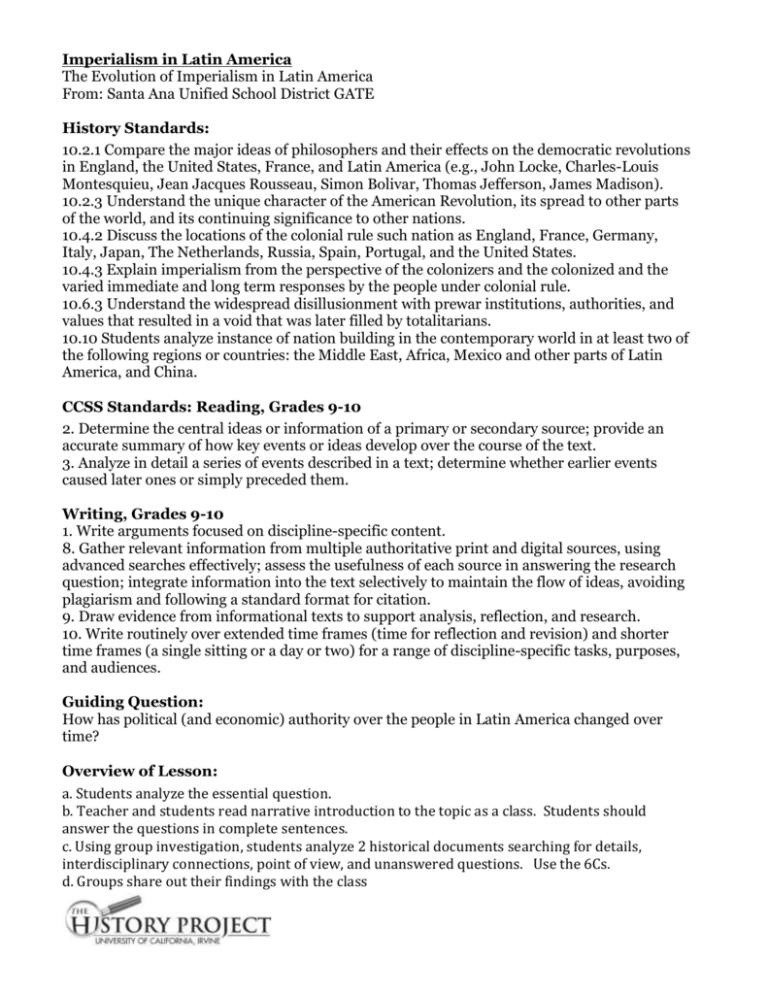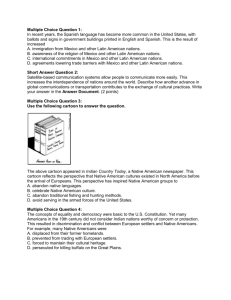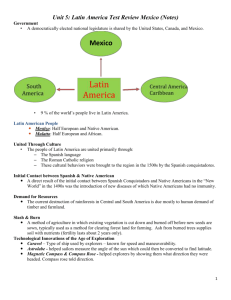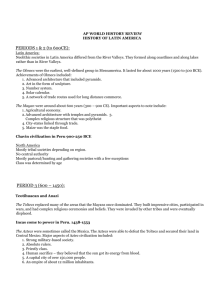10.10 - Imperialism in Latin America Lesson
advertisement

Imperialism in Latin America The Evolution of Imperialism in Latin America From: Santa Ana Unified School District GATE History Standards: 10.2.1 Compare the major ideas of philosophers and their effects on the democratic revolutions in England, the United States, France, and Latin America (e.g., John Locke, Charles-Louis Montesquieu, Jean Jacques Rousseau, Simon Bolivar, Thomas Jefferson, James Madison). 10.2.3 Understand the unique character of the American Revolution, its spread to other parts of the world, and its continuing significance to other nations. 10.4.2 Discuss the locations of the colonial rule such nation as England, France, Germany, Italy, Japan, The Netherlands, Russia, Spain, Portugal, and the United States. 10.4.3 Explain imperialism from the perspective of the colonizers and the colonized and the varied immediate and long term responses by the people under colonial rule. 10.6.3 Understand the widespread disillusionment with prewar institutions, authorities, and values that resulted in a void that was later filled by totalitarians. 10.10 Students analyze instance of nation building in the contemporary world in at least two of the following regions or countries: the Middle East, Africa, Mexico and other parts of Latin America, and China. CCSS Standards: Reading, Grades 9-10 2. Determine the central ideas or information of a primary or secondary source; provide an accurate summary of how key events or ideas develop over the course of the text. 3. Analyze in detail a series of events described in a text; determine whether earlier events caused later ones or simply preceded them. Writing, Grades 9-10 1. Write arguments focused on discipline-specific content. 8. Gather relevant information from multiple authoritative print and digital sources, using advanced searches effectively; assess the usefulness of each source in answering the research question; integrate information into the text selectively to maintain the flow of ideas, avoiding plagiarism and following a standard format for citation. 9. Draw evidence from informational texts to support analysis, reflection, and research. 10. Write routinely over extended time frames (time for reflection and revision) and shorter time frames (a single sitting or a day or two) for a range of discipline-specific tasks, purposes, and audiences. Guiding Question: How has political (and economic) authority over the people in Latin America changed over time? Overview of Lesson: a. Students analyze the essential question. b. Teacher and students read narrative introduction to the topic as a class. Students should answer the questions in complete sentences. c. Using group investigation, students analyze 2 historical documents searching for details, interdisciplinary connections, point of view, and unanswered questions. Use the 6Cs. d. Groups share out their findings with the class e. Students return to their group and discuss change over time using the 3 historical sources Students record their findings on a prewriting outline. e. Students respond to the essential question using the documents as evidence. Imperialism in Latin America In the 1400s competition for trade and control over resources in Asia existed in Europe. Many explorers sailed in search for an alternative trade route to Asia and its riches. Spain’s, Christopher Columbus never reached Asia, but instead discovered an island in the Caribbean. This marked the beginning of Imperialism in the Atlantic World. Soon after many other explorers desired claims in the Americas. Spain sent over several explorers to make claims and expand their empire. Hernando Cortes reached Mexico and the explorers who followed him were known as conquistadors. By conquering the Aztecs, Spain now had access to vast land filled with rich deposits of gold and silver. However in obtaining these riches the native people were often treated cruelly and were considered the lowest in society. This conquest allowed the Spanish to greatly enrich their empire causing them to leave a mark on the cultures of North and South America that exists today. 1. What caused imperialism in Latin America? 2. What was Christopher Columbus responsible for? 3. Why was Mexico valuable? After the Enlightenment and the successful American Revolution and French Revolution, ideas about who should control government were introduced in Latin America. Ideas of liberty, equality, and democratic rule found their way across the seas to colonies. At this time, Latin American society was divided into different groups: peninsulares were European born and could hold high office in Spanish colonial government. Creoles, were born in Latin American but had European decent. The creoles could not hold high political positions but they were able to hold high position in the Spanish colonial army. Together these groups controlled land, wealth and power in the Spanish colonies. At the bottom are Indians and people of mixed blood, mestizos and mulattos, who held no power or wealth. With the help of creole Simon Bolivar, Jose De San Martin, and Padre Miguel Hidalgo much of Latin America won independence from Spain by the 1820s. 1. What event caused political revolutions in Latin America? 2. Which two groups were the highest in society? 3. Which two groups were at the bottom of society? However, even after achieving independence, Latin America struggled to maintain political and economic stability. In Mexico, democracy began in 1920s. After WWI and the Great Depression, America and Great Britain began to dominate Latin America’s economy. Impoverished Indians and peasants caused many people to criticize capitalism and felt the interference from outsiders was a threat and return to imperialism. This period is called Neo-Imperialism. In order to repair the poor relations and maintain markets for export and import with Latin America, the United States created the Good Neighbor Policy which allowed Mexican migration into the United States. Hollywood also adopted singing and dancing sensation from Latin America, Carmen Miranda, to promote more positive images of Latin America. 1. What was Neo-Imperialism? 2. Why did the citizens think it was occurring? From 1934-1940 leaders tried to improve life for peasants and workers by passing labor laws and land reforms. The Mexican oil industry became nationalized and foreign oil companies were kicked out. After WWII, even though the Mexican economy rapidly developed, Mexico continued to struggle with severe economic problems causing many Mexicans to be unemployed and desperate for survival. The government owed huge foreign debts, which forced them to spend money on interest payments. Many citizens called for economic and political change. Then in the 1980s , huge new oil and natural gas reserves had been discovered in Mexico. The economy had become dependent on oil and gas exports. In 1981, world oil prices fell, cutting Mexico’s oil and gas revenues in half. Mexico went into an economic decline. 1. Describe Mexico’s economic status. 2. Why was their economy bad? 3. How did this influence the people? In 2000, Vicente Fox became president and had ambitious plans for Mexico. He advocated reforming the police, rooting out political corruption, ending the rebellion in Chiapas, and opening up Mexico’s economy to free-market forces. Fox also argued that the United States should legalize the status of millions of illegal Mexican immigrant workers in the United States. In the wake of the terrorist attacks of September 11, 2001, any such agreement appeared remote. However, in 2002, citizens who lived abroad, a great many of whom lived in the United States. In the meantime, Mexico’s democracy continued to strengthen. 1. Describe Fox’s plan to improve Mexico’s economy. 2. What is the economic and political status for current Mexican citizens? An Amerindian named Guaman Poma, who lived in Peru in the 1600s, created this drawing in order to describe working conditions in the New World under the Spanish.








